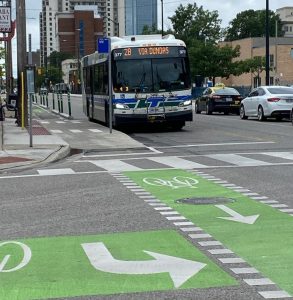Staff Report #1
August 25, 2021
To All Commissioners
Re: Cycling Infrastructure Update
Recommendation
The report be NOTED and FILED.
Background
At the June 30, 2021 Commission meeting, Staff Report #4 provided details on the City of London’s move towards a fully connected, accessible cycling network by installing new separated bike lanes throughout the city over the coming years.
As set out in the image below, transit riders will need to board and exit into the cycle lane. Given the introduction of an infrastructure design that will be new to all users, coupled with the potential for conflict between transit riders and cyclists, concerns regarding safety hazards have been raised. In addition, should transit riders require the ramp, an additional impediment will be deployed across the cycle lane.
Figure 1 – Dundas and Maitland

Recognizing the potential for unintended conflict between transit riders and cyclists, and concern for safety of all involved raised during discussions between London Transit and civic administration, education campaigns outlining expectations of all users have been developed in tandem.
The communication directed at the cycling community focuses on the requirement for cyclists to yield to pedestrians and stopping behind buses that are servicing bus stops whether there are people waiting for a bus or not, noting that unbeknownst to the cyclists, riders may be exiting the bus at any time and/or the ramp may be in the process of being deployed.
The communication to London Transit riders indicates that although it is anticipated that cyclists will adhere to these expectations, passengers should use caution when crossing cycle lanes both when boarding and exiting the bus. In addition, London Transit will be communicating with the CNIB to identify locations where this infrastructure is in use so that they can share with the visually impaired community, noting the potential for conflicts will be higher with someone with a visual impairment who will not see a cyclist approaching. London Transit Operators will also be asked to remind passengers with an identifiable visual impairment of the need for caution at these locations.
The communication channels for external communication include the following:
- City of London Communications Channels
- Signage along the cycle tracks
- Ramps and pavement markings
- Socials, including an educational video
- Website
- Meetings with the cycling groups and onsite media interviews
- London Transit Communication Channels
- Website, social media and on-board posters
- Regular emails to the CNIB
Internal communication to the Operator group have been shared with the messaging focussing on the use of mirrors to ensure cyclists have stopped especially prior to deploying the ramp.
For tracking purposes, London Transit’s Customer Service department will also be compiling contacts with concerns related to the cycle lanes. Data will be shared with appropriate civic administration staff. Updates to the Commission will be provided as appropriate.
Recommended by:
Caroline Roy, Manager of Corporate Communications
Katie Burns, Director of Planning
Concurred in by:
Kelly S. Paleczny, General Manager